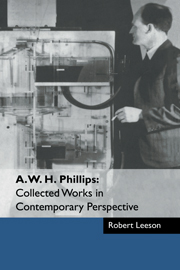Book contents
- Frontmatter
- Contents
- List of contributors
- Foreword by Arthur Brown
- Preface by Robert Leeson
- Part I Bill Phillips: Some Memories and Reflections
- Part II The Phillips Machine
- 8 The origins of the machine in a personal context
- 9 The Phillips Machine as a ‘progressive’ model
- 10 Mechanical models in economic dynamics
- 11 The history of the Phillips Machine
- 12 Early reactions to Mark I and II
- 13 A superb explanatory device
- 14 The Phillips Machine and the history of computing
- Part III Dynamic Stabilisation
- Part IV Econometrics
- References
- Index of names
- Index of subjects
13 - A superb explanatory device
Published online by Cambridge University Press: 04 May 2010
- Frontmatter
- Contents
- List of contributors
- Foreword by Arthur Brown
- Preface by Robert Leeson
- Part I Bill Phillips: Some Memories and Reflections
- Part II The Phillips Machine
- 8 The origins of the machine in a personal context
- 9 The Phillips Machine as a ‘progressive’ model
- 10 Mechanical models in economic dynamics
- 11 The history of the Phillips Machine
- 12 Early reactions to Mark I and II
- 13 A superb explanatory device
- 14 The Phillips Machine and the history of computing
- Part III Dynamic Stabilisation
- Part IV Econometrics
- References
- Index of names
- Index of subjects
Summary
It took a visionary man to design and construct this unique machine. The conception, elaboration and construction of the original model took place in the garage of a friend. It involved metal, liquid, plastic, electricity and glass. It could function linearly, but also could be used in an arbi- trary non-linear way by cutting a narrow slot in a stiff plastic, placed visibly on the front of this diabolic machine.
In the Cambridge economics faculty there was (and still is) this remark- able contrivance. It was placed on one side of a lecture room in a large enclosure, facing many windows, thus allowing close observation while functioning.
The elaborate necessary machinery was all behind the large metal face of the machine, but the behaviour when in use took place in the front of the machine so that it was feasible for a moderate sized group to watch how a dynamic linear, or nonlinear, dynamic process slowly evolved with changing quantities and rates of flow. By comparison with present-day computers, it was large and cumbersome, but for communicating the dynamics of either linear or non-linear aggregative problems, it was a superb explanatory device. By linking up two machines, it was possible to introduce mutual controls, so that one had a very much wider set of varieties of interdependent behaviour.
Having successfully designed and built such a splendid machine, Bill Phillips should have become rich in consequence of its production and Sale.
- Type
- Chapter
- Information
- A. W. H. Phillips: Collected Works in Contemporary Perspective , pp. 118 - 119Publisher: Cambridge University PressPrint publication year: 2000
- 4
- Cited by

